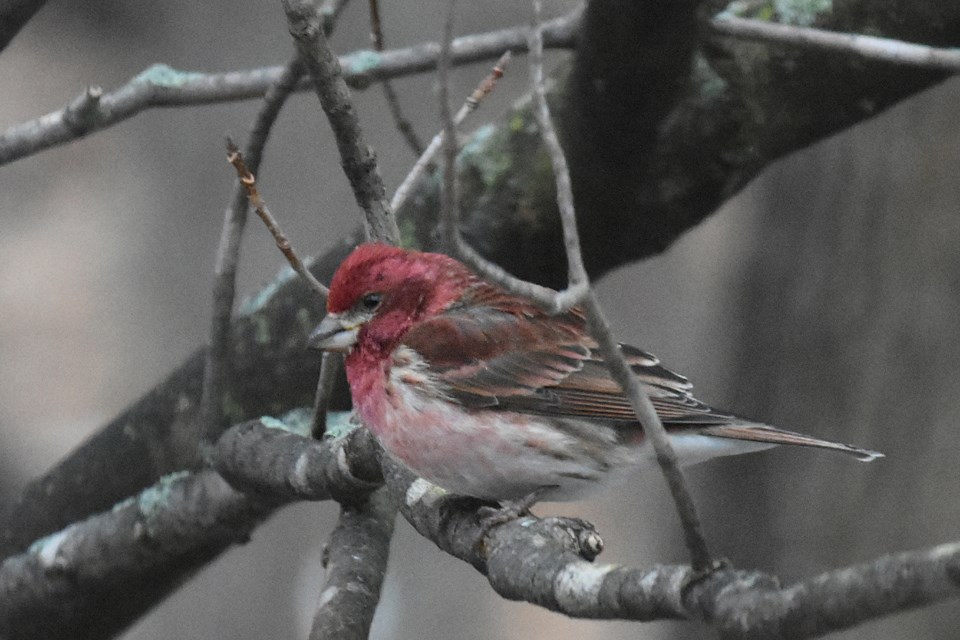As any bird feeder operator will tell you, part of the fun is watching for the arrival of a new species. You have to admit that the daily count of three chickadees and four blue jays, day after day, does lose a bit of glamour after a while, so when a newbie shows up there is great excitement to be had!
That new arrival may be a species “never before” seen at your feeder or it may be one that only occasionally drops by, like a brown creeper or red-bellied woodpecker. And other bird species seem to be on a very sporadic migration pattern, perhaps with several years between sightings.
It was one within that second group that showed up here last week ... a purple finch!
While we do have a mob of about a dozen juncos mixing in with the chickadees, a larger bird was noted sitting on a spruce branch. Larger, light in colour and with a noticeably heavier beak than the others. My first thought was “fox sparrow” but that particular brand of bird is not due to pass through for at least another month.
A review of the field guide quickly confirmed it as a female purple finch, a feeder participant that has been absent around here for a few years.
These chunky finches can be found all over eastern North America (and beyond), breeding in the boreal forest region of our province. Their diet is almost all seeds and fruits, especially conifer trees like spruce, hemlock, balsam fir and tamarack, which is a good definition of the component of a boreal forest.
These conifer trees have a cycle of high production of cones for a few years, then a session of low production. When the cones are scarce, the purple finches flow southwards in search of food. This tickles the fancy of us southern Ontario birdwatchers, as suddenly the winter woods are full of these finches and their seed-eating contemporaries, the crossbills and siskins.
When a feeding station full of black-oil sunflower seeds is encountered, these birds will certainly take advantage of their good luck at finding this cache. If you should be so lucky as to have pine siskins and goldfinches arrive as well, take note of the feeding hierarchy: despite their smaller size the siskins are the boss birds and feed first; then the purple finches are allowed in, but with females being dominant over males; then the goldfinches may come in for the scraps.
In the wild, purple finches are masters at seed extraction from cones or from within fleshy fruits. They can manipulate their strong beaks to separate the hard seed from within and then crush open the hard centre. What this means is that the plant’s seeds are not spread via bird poop as happens with many other avian species; when a seed gets eaten by a purple finch, it’s the end of the line for seed distribution.
On a nice sunny spring-like day the males will call with a very melodious song. Studies have revealed that these birds will insert portions of the songs of other birds within their own: the musical licks of barn swallow, American goldfinch, eastern towhee and brown-headed cowbirds have been detected within the purple finch’s repertoire (good thing for these finches there is no equivalent of Taylor Swift copyright lawyers).
There was a time when their songs were a lure for humans who liked to have their birds caged, not wild. It was quite fashionable in the early 1900s to have caged canaries and finches inside the home, filling the home with beautiful song. This fad spilled over to include a cousin of the purple finch, the house finch, which was imported from California (its home range) and brought to the eastern side of the continent. They were sold as “Hollywood Finches.”
In 1940 society shifted its fickle desires to other things and finch sales bottomed. A New York pet store owner released all his stock to the great outdoors of Central Park, and the house finches found that living in the East was just as good as it was back home in the West, so they flourished.
Like any ‘introduction’ there was a negative impact, and the house finches out-competed the purple finches for food and nesting territory. But as the purple finches nested mainly in the far north, the house finches remained around the lower Great Lakes.
So keep your feeders full ... we went from one finch to six over a couple days. Now comes the daily hope that maybe, just maybe, the pine siskins will be swooping in very soon.



